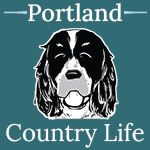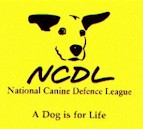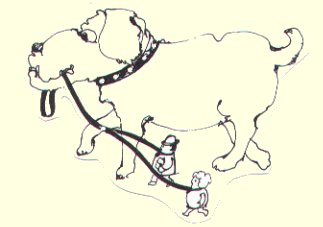|
Co-sponsors of the 2023 Winning Out
Certificates



| |
A dog may be for life
Hopefully those little bug**** are not!
 If your
dog has ever had fleas, you will know just how difficult it can be to treat them. The National
Canine Defence League answers some of your questions to enable you to take appropriate action
to avoid your dog suffering with a flea problem. And if all else fails,
here are some safe natural alternatives. If your
dog has ever had fleas, you will know just how difficult it can be to treat them. The National
Canine Defence League answers some of your questions to enable you to take appropriate action
to avoid your dog suffering with a flea problem. And if all else fails,
here are some safe natural alternatives.
- A dog will almost certainly suffer from a flea
infestation at some point during its life.
- The number of fleas would normally decrease during the
cold winter months. However, as most houses are now centrally heated, fleas are provided with
an ideal environment in which to survive all year.
- The length of the flea life-cycle depends on
temperature and humidity. In an ideal environment, the cycle can be around 21 days.
- By far the most common flea in dogs (and cats) is the
cat flea Ctenocephalides felis.
- Some dogs will develop a hypersensitivity to flea
saliva, and this can lead to an itchy reaction.
- One or two fleas would be quite enough to cause a
marked irritation.
- Most flea reaction in dogs are seen on the lower back
area, above the tail.
- Fleas spend the majority of their life-cycle in the
home environment. Only adult fleas are seen on the dog.
- The female flea lays eggs on the dog's coat. These
fall off and can be found wherever your dog spends most of its time - in its bedding, in the
carpet, on the sofa, or even in your bed!
- The flea lives by ingesting blood from your dog
several times a day.
- More often than not, an owner will notice small specks
of grit on the dog's coat. To establish whether this is flea dirt, brush the coat and allow
the material to fall onto a moist white tissue. Flea dirt will produce a red mark.
- Dogs can also pick up fleas from outside the home or
from other animals.
- Adult fleas do not live for long on your dog and die
after 7-14 days, only to be replaced by the ones developing in the environment.
- Fleas are also the intermediate host of the tapeworm.
Therefore, it is important to remember when treating your dog for fleas to treat him for
tapeworms too.
- Effective flea treatment and control involves treating
both the environment and the dog for all the reasons state above.
- Flea preparations come in all forms - aerosols,
powders, pump action sprays, insecticidal and herbal collars, spot-ons, oral tablets or
shampoos.
- Treatment of the environment involves using a
recommended aerosol spray and regular vacuuming. Don't forget under the skirting boards,
under the sofa and the dog's bedding.
- There are a large number of flea products available.
Ask your local veterinary surgeon for advice on which products will suit you and your dog's
needs.
Life-cycle of the Flea
- The female flea lays eggs on the dog's coat, which
drop off in the dog's bedding, carpets, sofa.
- The eggs hatch into larvae.
- The larvae develop by feeding on organic debris (flea
dirt) in he environment. At this stage the larvae may become infected by tapeworm eggs.
- The active larvae forms a 'cocoon' (pupa) in which the
flea forms. The adult flea will emerge from the cocoon in 10-17 days but may often remain in
this stage for months, so it is important to treat the environment all year round.
And remember prevention is better than cure!
NCDL
17 Wakely Street, London EC1V 7LT
Tel. 0171 837 0006
Web site: http://www.ncdl.org.uk
Reprinted by kind permission of the National Canine
Defence League (NCDL)
 Some flea control
products can be toxic to people and pets, if used incorrectly. Here are some
alternative suggestions to commercial flea collars which are safe and sweet. Some flea control
products can be toxic to people and pets, if used incorrectly. Here are some
alternative suggestions to commercial flea collars which are safe and sweet.
Since fleas breed around the neck, a flea collar is a
good deterrent. Conventional flea collars can reek of powerful chemicals which usually make the
animal feel unwell for a few days until the fumes have wanted. Essential oil collars, on the
other hand, not only small pleasant but are infinitely less toxic. Even though they need to be
replaced more often than conventional ones, this would seem a small price to pay for the long
term health and comfort of your dog.
Inexpensive, non-medicated fabric collars are widely
available from pet shops and markets. The easiest way to permeate the fabric with essential
oils is to dip the collar in a mixture of essences and cider vinegar, then keep the collars in
a seal polythene bag for 24 hours to encourage maximum diffusion.
Once in use, the collar will need to be replenished with
the oil and vinegar every two or three weeks. It may be wise to alternate between two or three
different formula as animals may have an idiosyncratic sensitivity to a certain essential oil.
If symptoms such as sneezing or skin rash occur, you should remove the collar immediately.
Citronella is an essential oil most likely to cause allergic reactions.
 Three Recipes for Do-It-Yourself Collars
Three Recipes for Do-It-Yourself Collars
Here are three suitable blends that you can do at home
using low to medium-priced essences:-
Recipe 1
- 1 teaspoon cider vinegar
- 5 drops cedarwood
- 5 drops eucalyptus
- 5 drops lavender
Recipe 2
- 1 teaspoon cider vinegar
- 5 drops rosemary
- 5 drops red thyme
- 5 drops cypress
Recipe 3
- 1 teaspoon cider vinegar
- 8 drops tea tree
- 6 drops geranium
Other essences with flea properties include bergamot,
lemon grass, patchouli and pine.
Ticks
Ticks (blood sucking parasites) are an occasional problem which can be picked up in
long grass. A drop or two of eucalyptus oil directly on the body of the tick will cause it to
drop off. Reprinted from Burns News Letter (Issue 3, September 1997)
Warning: If you are using conventional flea
collars, be sure to read the label thoroughly and follow instructions. If your dog exhibits
vomiting, loss of appetite or muscle tremors after treatment, contact your veterinarian.
| |
|